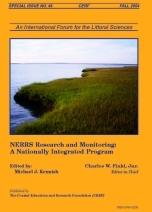Nonparametric harmonic analysis, a new data-analytic method for deconvoluting and graphically presenting the periodic signals in water quality time-series data, is demonstrated using data from the System-Wide Monitoring Program (SWMP) of the Sapelo Island National Estuarine Research Reserve (Georgia). The analysis uses the new statistical technology known as generalized additive models, an alternative to the classical harmonic regression analysis used for centuries to model and predict tidal forcing. Generalized additive models are especially well-suited for data-rich settings in which strong and nonsinusoidal periodic signals are expected. Data from two sampling sites on Sapelo Island, Georgia, show strong and regular M2–dominated periodicities in water depth. At the Hunt Dock (HD) site, water temperature, pH, and dissolved oxygen (DO) have strong diel signatures in the summer months, but these weaken in colder months. DO and pH at this site also exhibit tidal-cycle patterns at times, particularly in fall and late summer, with lower pH and DO occurring at low tides. At the Lower Duplin (LD) site, there is again a seasonally varying diel signal for temperature but little or no diel pattern for pH or DO. All three of these variables at LD show some patterns versus the tide, with higher temperatures and lower pH and DO values recorded at LD low tide. Salinity has a strong and fairly regular M2-dominant cycle at the LD site, with higher amplitudes in January–April. In contrast, salinity at the HD site displays trends of 5–10 ppt lasting a fortnight or more, with complex and inconsistent diel- and tidal-cycle patterns, which we believe to be influenced by freshwater intrusion events that created some inconsistency in the cyclic fluctuations found. Mild hypoxia, with DO at or slightly below 20% saturation, occurred at both sites with some regularity in late summer, usually associated with the pattern of declining DO at low tide.
How to translate text using browser tools
1 November 2004
Nonparametric Harmonic Analysis of Estuarine Water-Quality Data: A National Estuarine Research Reserve Case Study
Don Edwards,
Dorset Hurley,
Elizabeth Wenner
ACCESS THE FULL ARTICLE

Journal of Coastal Research
Vol. 2009 • No. 10045
Fall 2004
Vol. 2009 • No. 10045
Fall 2004
diel periodicity
generalized additive models
National Estuarine Research Reserve System
nonparametric regression
scatterplot smoothing
semiparametric regression
System-Wide Monitoring Program (SWMP)




